Five years ago, Wachovia was struggling. Flagging service standards forced customers to fend for themselves or consider taking their banking business elsewhere.
But walk into any Wachovia branch today, and it's clear that the people and technology there are geared to give banking customers the service and advice they want. In addition, Wachovia is now a top performer among the nation's largest banks, boasting a three-year return to shareholders of 86%.
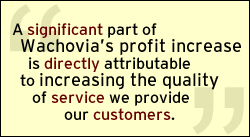 |
What changed in the intervening five years?
Many things -- from the faces in the boardroom and executive suite to the strategy driving Wachovia Corporation, one of the nation's largest financial services companies. Specifically, the company deliberately sharpened its focus on its four core businesses, articulated a vision and values all employees share, launched a new brand on the heels of a huge merger, upgraded its technology, and established clear definitions of what constitutes success. Now Wachovia has $411 billion in assets, 2,500 branches, 85,000 employees, and 12 million customer households and businesses.
But one crucial success factor was management's decision to focus its efforts on maximizing service quality and customer loyalty across the company. Ken Thompson, Wachovia's chief executive officer, says, "We determined that we had to concentrate on providing the best possible service to our customers if we were going to succeed. There was no higher priority."
How effective was this strategy? Bob Kelly, Wachovia's chief financial officer, says, "A significant part of Wachovia's profit increase over the past several years is directly attributable to the bank's tremendous success in increasing the quality of service we provide our customers."
As Thompson, Kelly, and others would surely attest, Wachovia's success in building customer loyalty offers a clear model for other companies. And Wachovia shows that increasing loyalty should be an essential element in every company's effort to grow its bottom line.
Problem diagnosis
Today's Wachovia is the result of the 2001 merger of First Union Corporation and Wachovia Corporation. Throughout the 1980s and 1990s, First Union expanded rapidly through a series of acquisitions that saw the North Carolina-based company grow to become the nation's sixth largest bank, with offices in 12 East Coast states.
In 1998, First Union experienced some well-publicized problems involving acquisitions in Pennsylvania and California and issued earnings warnings in 1999 as troubles mounted. By 2000, operating earnings per share were down 21% from 1998, and the company's total return to stockholders was down 56%. A major corporate restructuring took place in June, followed by the announcement of a merger with Wachovia -- a North Carolina bank that also had grown through acquisitions in several neighboring states -- in April 2001.
But when trouble first appeared late in 1998, First Union's management team began to diagnose major underlying problems. What became obvious was that while assimilating its merger partners over the years, the bank lost focus on the essential requirement that customers receive the best possible quality of service.
As all good managers know, recognizing a problem is only the first step toward solving it. The real challenge for any large company is to do something that significantly improves the situation and corrects the problem.
The big management challenge: getting all employees focused on improving service quality and significantly increasing customer loyalty while simultaneously boosting sales and enhancing profitability.
Commitment to service quality
In recent years, most major companies have realized that improving service quality and increasing customer loyalty are key to driving their bottom-line performance. Still, many businesses treat these crucial factors as marketing functions or operations responsibilities. This misconception, according to Gallup Organization research, is one of the major reasons why so many efforts to improve service and boost engagement have failed.
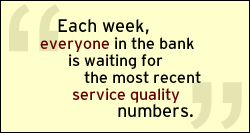 |
Wachovia, however, recognized that the company could only achieve a service quality transformation if the senior management team made it a top priority. Over the course of three years, Wachovia did this by:
- committing to consistently measure and monitor customer service quality
- using the service quality "numbers" just as management uses its financial numbers: to establish goals, measure and reward performance, and make changes to reach established goals
- designating an executive-level "Service Quality Champion" whose sole job is to boost service quality measurements
- designing monthly high-level Service Quality Meetings that hold leaders responsible for improving service quality performance. At these working sessions -- chaired by the CEO and run by the Service Quality Champion -- department and division leaders report on and review the bank's many service metrics.
Wachovia also formed a partnership with Gallup to help the company establish and enhance its Service Measurement Program and evolve it into a superior customer loyalty effort.
Reflecting on the way management uses its service measurement numbers, Beth McCague, Wachovia's service excellence director from 1998 to 2003, says, "Each week, everyone in the bank is waiting for the most recent service quality numbers. Just as we do with our financial and sales numbers, everyone from tellers to top managers celebrates when our service quality numbers show improvement, and we look for ways to immediately change things when they do not."
Measurement and incentives drive performance
Although top management's commitment to improving service quality and customer loyalty is essential, it's not sufficient in itself. Of the many companies that have attempted to create programs aimed at increasing their service and loyalty, Gallup has found few that seem willing to fully support programs that aggressively encourage their team leaders to improve performance.
This isn't the case at Wachovia.
Wachovia's Service Measurement Program is a model of what a successful program looks like. It's based on six key principles:
- To manage service quality, companies must be able to measure it at the team level.
- To improve service quality, companies must measure the key factors that affect service quality and customer loyalty.
- To improve performance, companies must develop effective incentive programs that significantly reward performance.
- To maximize effective employee communications, companies must design a measurement process and incentive program that is relatively simple, has substantial face-validity, and is easy to understand.
- Communications and training related to the program must be continuous.
- Measurement, intervention, and coaching must take place with the individual customer-facing employees as close to the time of their interaction with the customer as possible.
Many corporate programs have some, but not all, of these characteristics. For example, some companies measure the service quality they provide, but at the company level -- which means they don't know how individual teams are performing. Similarly, some companies measure the wrong things. Others hesitate to create significant incentives. Some simply offer lip-service support from key leaders.
Individual coaching
Since 1999, the Wachovia Service Measurement Program has evolved in many significant ways. Probably the single biggest enhancement to the program has been Personal Service Feedback (PSF). This process gives team leaders the information they need to continuously coach employees using up-to-date customer feedback.
As part of PSF, Gallup surveys customers who have visited a bank branch or phoned a call center during the previous week. Within two weeks, everyone from the employee involved in the transaction to top management knows how the customer rated that interaction. Leaders use the system's weekly reports to focus attention and praise on areas that are performing well -- and to take corrective action in areas that are under-performing. Service leaders use the information to help team leaders analyze processes that may be creating service quality issues. And team leaders use the information to coach individual employees on what they have done well and where they need to improve.
"PSF gives us the ability to provide coaching to individual employees very soon after they interact with the customer," says Cece Sutton, who heads the bank's retail banking segment. "We find this kind of coaching to be very effective in improving the service performance of our employees. PSF has improved our ability to provide best-in-class service quality across our franchise." In Gallup's experience, the ability to intervene at the individual and team levels on a timely basis is key to consistently and significantly improving service quality and customer loyalty.
Reduced attrition and increased profits
In 19 of the past 20 quarters, Wachovia has posted quarterly increases in its service quality -- a remarkable achievement for any company over a five-year period. The fact that Wachovia has topped all Top 20 banks in the University of Michigan's American Customer Satisfaction Index (ACSI) for the past three years is further confirmation of the company's success in improving the quality of service it provides to customers.
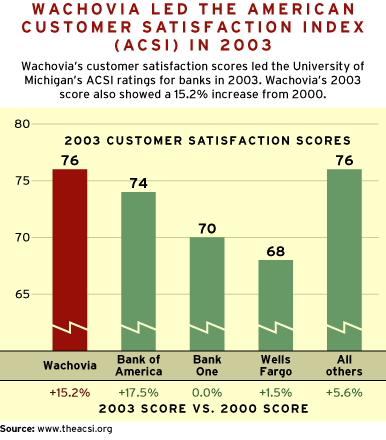 |
Over that same period, customer attrition at Wachovia has plunged from an annual rate of 20% in the first quarter of 1999 to 11% by the first quarter of 2004. At the same time, Wachovia's retention of its most profitable customers has increased from 92% in 1999 to 98% in 2003. As Gallup's research shows, increasing service quality and customer loyalty is one clear way to significantly reduce customer attrition.
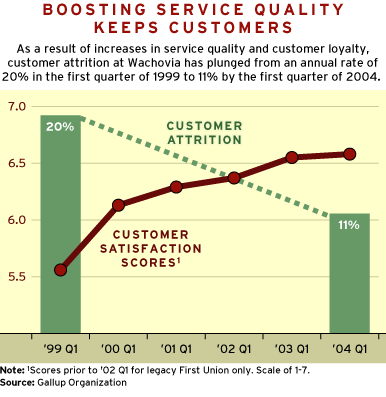 |
The sharp improvements in Wachovia's service quality have also coincided with significant increases in Wachovia Corporation's growth and profitability. The bank's low-cost core deposits have grown 17% over the past year -- twice as fast as those of its peers. At the same time, its retail and small business loans have increased by 11%.
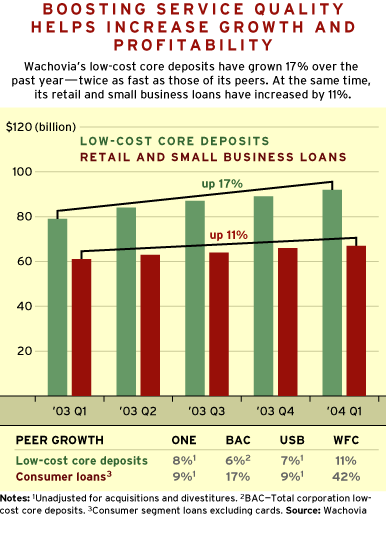 |
Wachovia's return to its stockholders increased 86% during the 2001 to 2003 period.
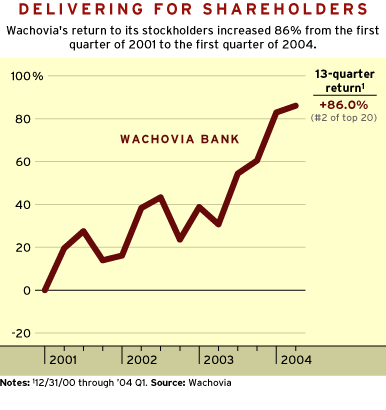 |
Making a big merger work
Wachovia's greatly increased customer focus was also a guiding principle during the successful merger of First Union and the former Wachovia, which took place between April 2001 and July 2003. "Our merger has gone extremely well for several reasons," says David Carroll, who co-headed the company's merger integration project team. "One, successful execution was the company's top priority. Two, we followed a painstakingly well-thought-out integration plan. But perhaps most important, no decision was made without a thorough analysis of its potential impact on the customer."
Gallup's research reveals that when management and employees are distracted by a major merger effort, companies routinely suffer a significant and prolonged drop in service quality -- which makes Wachovia's achievement all the more remarkable. Wachovia's customer scores dipped just once between the first phased conversion -- in Florida in November 2002 -- and the end of the conversions four quarters later in the company's New York, Pennsylvania, New Jersey, Connecticut, and Delaware markets. Increases were noted in all other quarters.
Steve Boehm, who leads the bank's call centers, puts it this way: "Because we paid such close attention to how decisions impacted customers every day and every step of the way -- both in bank branches and call centers -- we ultimately succeeded."
Looking to customer engagement
Given Wachovia's success in increasing service quality across its branch network, many management teams would be tempted to chalk this up as "mission accomplished" and turn to other things. Not so at Wachovia.
"We must take advantage of our tremendous service quality momentum," says Ben Jenkins, who leads Wachovia's General Bank. "We must continuously ask ourselves what more we can do to improve the customer's experience at Wachovia." This challenge by the bank's senior leadership has led to an even greater focus on the customer, and the bank is increasing the frequency with which it measures customer loyalty and customer engagement.
A new study completed in March 2004 shows that Wachovia has already succeeded in increasing its customer loyalty and its customer engagement over the past couple of years:
- Wachovia's percentage of loyal customers increased from 47% in early 2002 to 51% in early 2003; it now stands at 58% as of March 2004. This significant increase means that Wachovia has moved from above the 70th percentile of Gallup's Large Bank Retail Banking Database to above the 90th percentile.
- Wachovia also increased its customer engagement score, as measured by Gallup's CE11 metric, in early 2003 and again in early 2004. This places Wachovia at the 90th percentile of Gallup's Customer Engagement Database.
Wachovia leaders won't be satisfied until their performance tops that of all banks in Gallup's CE11 database. They realize that most Wachovia competitors are also focusing on their customers, so the company must continue to improve. They also recognize that community banks and credit unions have much higher levels of customer loyalty and customer engagement than are reflected by Gallup's CE11 database.
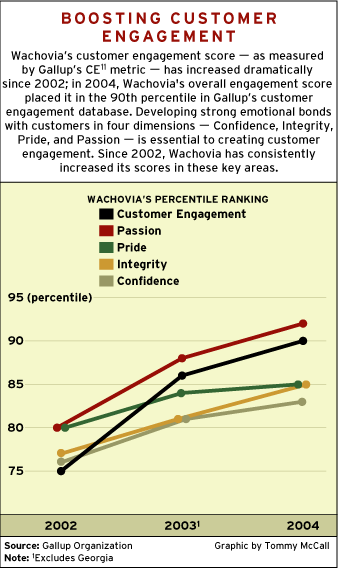 |
Above all, Wachovia recognizes that every loyal and every engaged customer it can develop will add significantly to the company's bottom line. Data from Wachovia's Customer Engagement Study of 2003 show that loyal and engaged customers are much more likely than other customers to:
- look to Wachovia first the next time they need financial services
- increase the business they do with Wachovia
- increase their share-of-wallet with Wachovia in terms of deposits and loans
- increase the amount of deposits they have at Wachovia
In other words, increasing customer loyalty and engagement dramatically increases productivity -- and profitability.
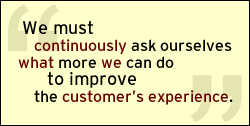 |
Building on the momentum
Wachovia has devoted much time and attention to service quality over the past five years, and it clearly has momentum. "We recognize that we need to continue nudging ourselves forward or we risk losing our distinct competitive advantage in customer service quality," says Gwynne Whitley, the company's new service excellence director. "That's an asset we don't want to lose."
So it's not surprising that Wachovia's management team has decided to build on its service quality momentum in 2004 by increasing its focus on customer loyalty with an eye toward adding more engagement enhancements in the future.
Wachovia has good reason to look forward to even better customer relationships and bottom-line outcomes in the years ahead.